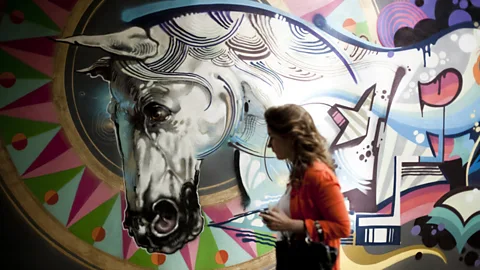New economies shake up the art world at Venice Biennale


The art world is looking beyond its major centres for the next big thing, reports Georgina Adam from the Venice Biennale.
A shower of gold coins rains on female visitors holding transparent umbrellas as they peer up through a hole in the ceiling of the Russian pavilion at this year’s Venice Biennale. Only women are allowed into the ground floor room, although anyone can watch from upstairs. The coins are shunted up a conveyor belt and then released from a pierced circular orb at the top of the building.
In an adjoining room, a banker seated on a riding saddle, perched high above the crowds, flicks peanut shells downwards at visitors. The installation, by artist Vadim Zakharov, refers to the myth of Danae, who was wooed by the Greek god Zeus in the form of a golden shower, as well as the greed and indifference of the culture of money.
While Russia has had a pavilion at the Biennale since 1914 (and Russian artists have participated since the event was founded in 1895), such is the overwhelming importance of the event, often dubbed the ‘Olympics of art’, that it now reflects a globalised art world. This year sees ten new national participants, including Paraguay, Kosovo, Bahrain, Kuwait, the Bahamas and even tiny Tuvalu, in the South Pacific, an island with a population of just 12,000. Other arrivals this century were China, Mexico, the United Arab Emirates and India, which first exhibited in 2011 but did not return this year.
In addition to the national pavilions, a bewildering array of peripheral events brought emerging Saudi artists to Venice in a show called Rhizoma, and Central Asian ones in Love Me, Love Me Not. Others from Palestine, Taiwan, Korea, at least eight shows by Chinese artists and two installations by Ai Weiwei, reflect the unstoppable broadening of the art world. And institutional interest is there: museums such as London’s Tate, the Metropolitan Museum of Art (MoMA) in New York and the Centre Pompidou in Paris are taking an increasingly active role in collecting art from around the world. Tate recently formed an acquisitions committee for African art, and already has such bodies for South East Asia, Latin American and the Middle East.
Going South
There is much talk today of the ‘global south’ – southeast Asia, Africa, the Caribbean and Latin America, in contrast to the ‘global north’, the established centres of the art world. In this context it was interesting to listen to Michael Govan, director of the Los Angeles County Museum of Art (LACMA). He was in Venice for the Biennale, and for the inauguration of Prima Materia, the new show at Punta della Dogana, one of two Venetian museums belonging to the luxury-goods mogul and Christie’s owner François Pinault. Govan co-curated the show with Pinault’s advisor Caroline Bourgeois.
Govan is on a mission to rethink the museum of the 21st Century, hopefully after he manages to pull off a bold new plan to rebuild completely the current mish-mash of mid 20th-Century buildings which house the LACMA. And along with this plan is the desire to shake up how art is displayed, to shift its focus westwards towards Asia, and southwards, towards Latin America.
Almost half the population in Los Angeles is of Hispanic descent and it has a solid Asian population, explains Govan. “Our sense of the world is changing,” he says, “because of globalisation and accessibility to the internet. The criteria of traditional art history are shifting. I want to revise the accepted idea that time is a straight arrow – in Asian or Pre-Colombian cultures, for example, time is not conceived that way, it is more circular.”
Global market
So, if Govan succeeds in his project, the new museum will display far more works of art, a move away from the ‘few masterpieces’ culture which he says is of the past, and be far more inclusive. “There will be virtually nothing left in store,” he says: “I want not just to exhibit culture, but to build a culture in what is still an experimental city.”
Now, you might ask, what has all this got to do with the art market? A great deal, because the way museums display art is a major part of the ‘endorsement’ process that recognises the artists they choose as significant and relevant. The inclusion of art from previously under-represented countries marks a seismic shift in the way it is perceived – and consecrated. This in turn impacts on their prices, as collectors follow the museums’ lead in seeking out new directions and compete for works.
The art market is supply-driven, and the globalisation of the art world has also brought a supply of new art and artists, to match the increasing firepower of collectors in ‘new’ economies such as China, India, Indonesia or Brazil. As well as Western museums now collecting art far more globally, these ‘new’ economies are establishing their own museums – in some cases, such as in the Gulf or Central Asia, through public patronage, in others, such as India or China, through private initiatives. This also explains the phenomenal growth in the market for contemporary art in this century.
Venice, in all this, remains the key event, a meeting place for artists, curators, museum directors and the art trade. And when the art fair Art Basel opens this week, with exhibitors from 37 countries, you can be sure that dealers will point out when “the artist is currently on show in Venice.”
